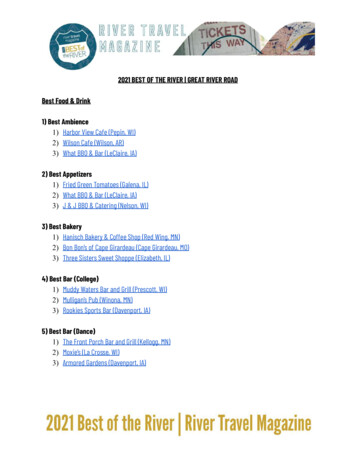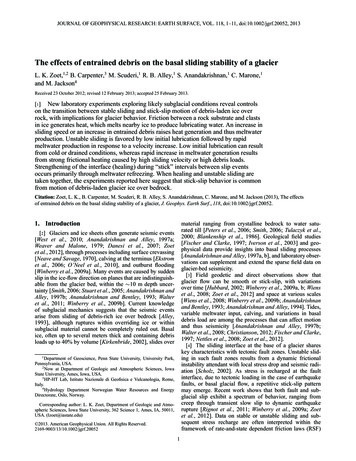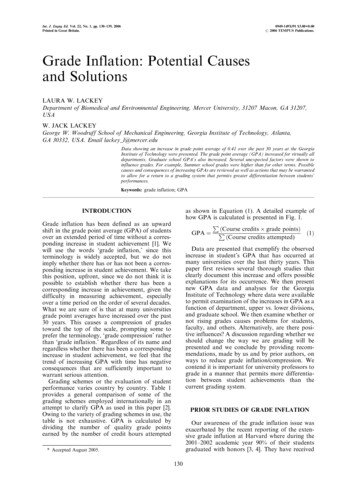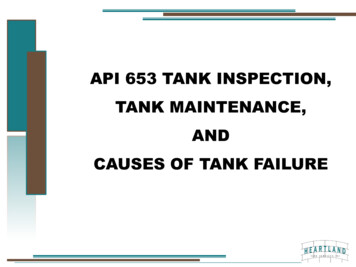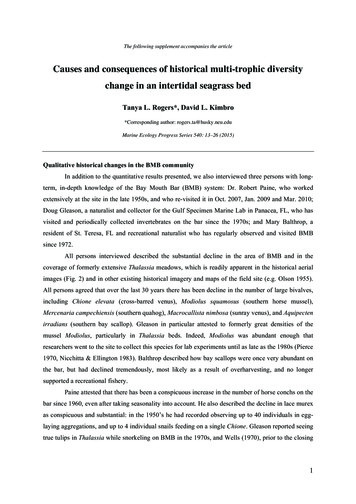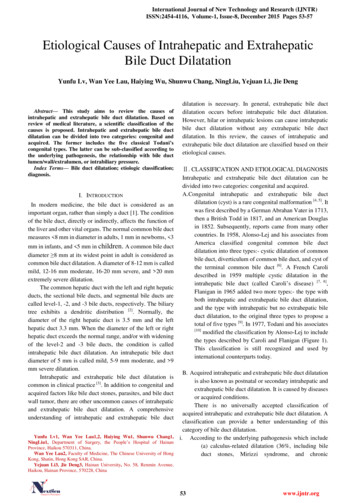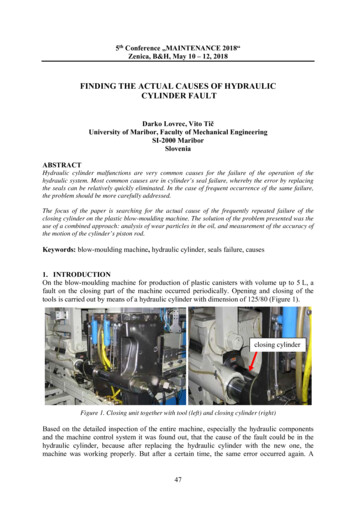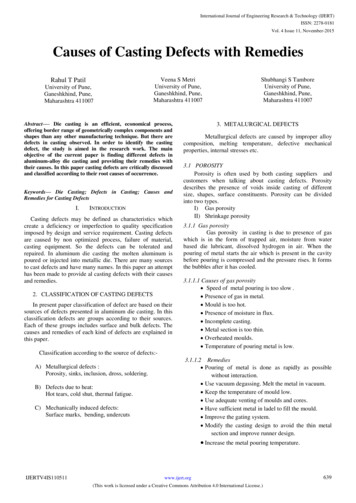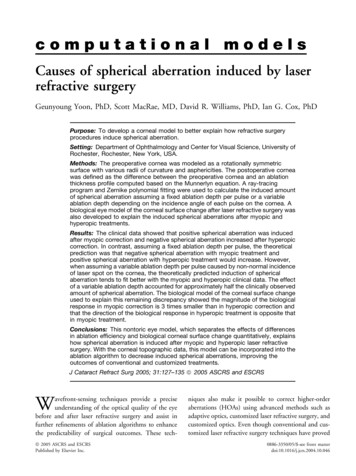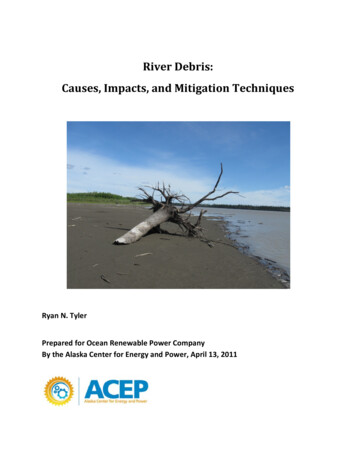
Transcription
River Debris:Causes, Impacts, and Mitigation TechniquesRyan N. TylerPrepared for Ocean Renewable Power CompanyBy the Alaska Center for Energy and Power, April 13, 2011
AbstractPerhaps the greatest obstacle that confronts the implementation of commercial‐scale hydrokineticdevices in rivers is debris. Until recently, this problem has been largely avoided by installing devices inareas where debris is not a factor. This practice significantly limits the possible locations for deployment,however, so new techniques must be developed. Although there is little precedent for largehydrokinetic devices and the issue of debris, there are examples of efforts to protect other engineeredriverine structures. In addition to presenting these examples, we discuss the mechanisms for how debrisenters the flow and is transported downstream, as this information can provide important insight in thedevelopment of debris mitigation strategies.ii
AcknowledgmentsThe author would like to thank all those who offered support, advice, and knowledge. In particular,Professor Jerome Johnson of the Alaska Center for Energy and Power for his continued guidance and forhis help contacting experts in the field. Gratitude is also extended to Jack Schmid for his help compilingevidence of debris and his photographic expertise.Recognition and gratitude goes to BP for their financial support of my research position. In addition, thefunding from the Denali Commission through an ORPC‐funded project was instrumental, as was thesupport from the Alaska Energy Authority's Renewable Energy Fund for the Nenana ConstructionProject.iii
Table of ContentsAbstract . iiAcknowledgments. iii1. Introduction . 12. River Debris Characterization . 22.1Causes and Types of Debris . 22.2Debris Transport . 32.3Impact Forces of Debris on Engineered Structures . 52.4Debris Accumulation . 63. Existing Debris Mitigation Techniques . 63.1Upstream Debris Diversion Techniques . 63.1.1Treibholzfange debris detention / debris basins . 73.1.2Debris booms . 73.1.3Debris fins . 73.1.4River training structures. 83.2Near‐Field Deflectors and Sweepers. 83.2.1Debris sweepers . 83.2.2Debris deflectors . 93.3Trash Racks. 113.4Techniques Currently Used with Hydrokinetic Devices . 133.4.1Device placement . 133.4.2Furling . 143.4.3Debris booms . 143.4.4Trash racks . 153.4.5Blade design . 163.4.6Manual debris removal . 164. Conclusions and Recommendations . 165. Appendices. 19Appendix A: Maximum impact forces of large woody debris on engineered structures . 19Appendix B: Estimation of the head loss through a trash rack of bars with various geometry . 21Appendix C: Determination of the natural and forcing frequencies associated with trash racks(from Lewin, 1995). . 23Appendix D: Details of trash racks that failed during operation (from Syamalarao, 1989) . 25Appendix E: Assessment of potential for debris production and transportation (from Lagasse etal., 2010) . 266. Bibliography . 28iv
1. IntroductionAnytime an engineered structure is placed in a river environment, the possibility exists that it willencounter debris. The impact of this debris on a structure is an important aspect of the design. Both theforce of the initial impact and the possibility of debris accumulation must be considered in determiningthe effect of debris on a structure. Historically, debris accumulation on bridge piers and hydroelectricdams has been among the chief concerns associated with river debris. As the amount of debris builds onan object, the force it exerts on the object can result in catastrophic failure and reduce the flow,resulting in the buildup of a backwater and greatly reducing the efficiency of energy conversion.Additionally, as floating debris accumulates on a structure, it will begin to push downwards, forcing theflow to the riverbed, greatly increasing scour (Saunders & Oppenheimer, 1993). In hydrokinetic devices,the effects of debris accumulation are even more profound, since a reduction in flow speed reduces thekinetic energy of the flow by the cube of the velocity reduction. The forces associated with debrisaccumulation can rapidly lead to catastrophic or near‐catastrophic failure in hydrokinetic devices.In the summer of 2010, a surface‐mounted 5 kW Encurrent Turbine from New Energy became nearlysubmerged in the Yukon River (Ruby, Alaska) after only a few days of debris accumulation (Figure 1).Although the device recovered from that particular debris incident, the Yukon River Inter‐tribalWatershed Council, which is responsible for the device, recently discontinued the testing of the turbinepartially due to continual debris issues and the danger to workers of associated uncontrolled debris.Figure 1: Debris accumulation on the 5 kW Encurrent Turbine barge in Ruby, Alaska (Johnson & Pride, 2010)Further up the Yukon River, during summer 2010, Alaska Power and Telephone (AP&T) installed asecond Encurrent Turbine in Eagle, Alaska. During initial deployment, the 25 kW device was consistentlychallenged by debris. While the device avoided catastrophic events, the turbine blades suffered fromdebris impact, the efficiency was hindered because of accumulation, and the power connection to theshore was continually compromised by submerged debris snares. As they prepare for their second waterseason, AP&T has identified the issue of debris as the most important problem that confronts theirturbine (Beste, 2011).On the Mackenzie River in Fort Simpson, Northwest Territories, another barge‐mounted EncurrentTurbine was installed in June 2010 by the Northwest Territories Power Corporation. As with the two1
turbines in Alaska, debris on the Mackenzie proved to be a formidable challenge. The turbine wasprotected by a debris boom, which was generally successful in deflecting surface debris. Despite theprotection from surface debris, the turbine was struck by a log in late June (Thompson, 2010). Thedamage suffered during the collision resulted in nearly two months of repairs and redesigns (Thompson,2010). As the Northwest Territories Power Corporation contemplates the future of the project, debriswill continue to be one of the main considerations (Thompson, 2010).Many studies have been made on impact mitigation of debris on traditional structures, such as bridgeabutments and hydroelectric dams, although quantifiable assessment of the efficacy of the studies hasnot been thoroughly documented. In hydrokinetic applications, attempts to solve the debris problemare mostly theoretical. Mitigation strategies currently practiced primarily exist in use with smallhydrokinetic devices, typically in remote areas.In order to develop approaches for larger commercial‐scale hydrokinetic devices, it is important tounderstand what type of debris a device is likely to encounter, the way the debris flows down a river,and the current debris‐mitigation strategies in place both for small hydrokinetic applications and fortraditional structures, such as bridge piers and hydroelectric dams.2. River Debris Characterization2.1 Causes and Types of DebrisDebris transport, including the type of debris, the mechanisms by which the debris enters the flow, andthe manner in which it moves with the flow, all depend greatly on the characteristics of the river and theenvironment through which it flows. Although debris type exists in a continuum, it is often helpful toconsider three main classifications for woody debris (Bradley et al., 2005). The first is small debris, whichincludes small branches, leaves, and refuse. Because of its small size, this debris can be transported intothe flow by a variety of ways. In addition to the mechanics by which larger debris enters the flow, smalldebris can enter through wind events and seasonal changes, resulting in loss of foliage (Bradley et al.,2005). Medium debris consists mostly of larger branches and can enter the flow through a smallertributary or runoff stream, because of bank erosion or the breakdown of larger debris, and throughflood events (Bradley et al., 2005). Large debris, consisting of very large branches and entire trees, canenter the flow in many of the same ways as medium debris, but with a few restrictions. Smallertributaries often do not have the flow rate or the width to transport large debris, so the debris does notoften enter the main flow via runoff. Large debris most commonly enters the flow either during a floodevent or because of bank erosion (Figure 2) (Bradley et al., 2005). Not surprisingly, the magnitude of aflood event and the concentration of debris within the floodplain also greatly affect the amount ofdebris that enters the flow. Any time there are long periods between flood events, debris problems canbe anticipated, and the first major flood event of the year typically carries the greatest amount of debrisinto a river (Chang & Shen, 1979). A suggested flowchart for assessing debris‐production potential(Lagasse et al., 2010) is shown in Appendix E.2
Figure 2: Large debris entering the flow due to bank erosion (photo courtesy of Jack Schmid, AlaskaCenter for Energy and Power, 2010)2.2 Debris TransportAlthough the manner in which debris is transported in a river greatly depends on the flow characteristicsand type of debris, some generalizations can be made. While medium and large debris can becomeentangled, it has been observed that floating debris rarely travels in large masses; this may be a result ofriver turbulence breaking apart the tangled debris (Chang & Shen, 1979). Despite this trend, entangleddebris is possible especially during high water in areas with heavy debris loads. Debris events containinglarge amounts of entangled debris can have significant consequences to engineered structures (Figure3). Chang and Shen (1979) observed that in straight sections of the river, floating debris tends to followthe thalweg at the rising stage of a flood event, but tends to gravitate outward toward the banks whilethe water level is falling (Chang & Shen, 1979). When the water is neither falling nor rising due to a floodevent, secondary flow currents tend to converge at the surface, resulting in the majority of floatingdebris concentrating along one path, which typically relates closely to the thalweg (Lagasse et al., 2010).Large debris is further restricted in how it is transported based on the size and flow of the river. As thelength of the debris approaches the width of the river, the likelihood that it will be transporteddownstream greatly diminishes (Bradley et al., 2005). In addition, as the sinuosity of the river
River Debris: Causes, Impacts, and Mitigation Techniques Ryan N. Tyler Prepared for Ocean Renewable Power Company By the Alaska Center for Energy and Power, April 13, 2011
